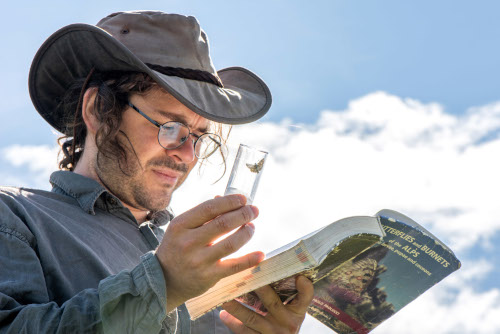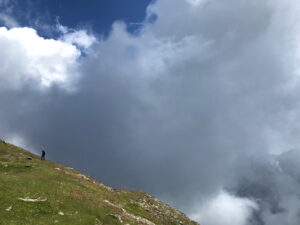With their beautifully colored wings, butterflies are undoubtedly among the most popular insects. However, the charismatic butterflies are not only beautiful, but also important beneficial insects: They are valuable pollinators and are thus indispensable for the survival of many plants. In addition, butterflies are important “indicator animals”, i.e. they provide information about the condition and quality of our environment, as they have specific habitat requirements. Elia Guariento is a butterfly expert working at Eurac Research’s Biodiversity Monitoring South Tyrol and has been researching this group in South Tyrol for the last four years. Some interesting conclusions drawn from his surveys has been now published in a new scientific publication.
Butterflies
Butterflies are one of the best researched insect groups. Accordingly, quite a bit is already known about their occurrence and habitats: For example, butterflies in Europe depend on grasslands, where most butterfly species find a valuable habitat. These grasslands have been partly created by human activities for hay production or grazing and are kept as such by agricultural use. Furthermore, it is known that many butterfly species are threatened or have already disappeared due to the intensification of agricultural practices. Therefore, many butterflies’ populations depend on the persistence of extensive management.
Results of the surveys
These trends are also shown by the results of Elia Guariento, who surveyed the occurrence of butterflies in the most important habitats of South Tyrol: Meadows and pastures, fields, apple orchards, vineyards and urban areas. “The surveys clearly showed that extensive grasslands, extensive meadows and pastures, support the most butterfly species and abundances. They also provide habitat for many endangered and specialized butterfly species,” explains Elia Guariento. Significantly fewer butterfly species occurred in a second habitat group used more intensively by humans, which includes orchards and vineyards, as well as crop fields and urban areas. The few butterflies that occurred in these habitats were mainly generalist and mobile species. Further results of the Biodiversity Monitoring South Tyrol illustrate that not only many and rare butterfly species occur in the extensive meadows and pastures, but that this is also true for other animal groups and plants. This illustrates that these habitats are extremely important for the preservation of biodiversity. Therefore, we have a great responsibility to protect these cultivated areas with high natural value for the future. Subsidies can support and value these cultivation practices potentially preserving them also in the future. Guariento particularly recommends subsidizing extensive pastures especially at lower altitudes, which are especially threatened by intensification and abandonment.
A special role for butterfly conservation is also played by semi-intensive grasslands, which are fertilized and mowed more frequently, are covering a bigger area, and are farmed also on lower altitudes, than extensive meadows and pastures. The latter two are mainly situated at higher altitudes and cover a smaller area. Although significantly fewer species occurred in these semi-intensive grasslands than in extensive grasslands, significantly more species were recorded than in the other intensive habitats. Therefore, incentives to regulate semi-intensive meadows, especially to prevent further intensifications are proposed. Furthermore, delaying mowing dates and alternate the mowing, leaving a portion of the area unmoved at a time can be measures used to improve the presence of butterflies in these semi-intensive meadows.
As far as settlement areas are concerned, Guariento was able to find large differences in the species recorded in the different settlement areas. This indicates that settlements could provide a habitat for different butterfly species. “To support the occurrence of butterfly species – and incidentally the occurrence of other pollinator insects – roadsides and parks could be mowed less intensively or not mowed at all, and flower strips could be sown,” Guariento recommends.
The paper
The scientific paper of Elia Guariento can be found here:
Guariento E, Rüdisser J, Fiedler K, Paniccia C, Stifter S, Tappeiner U, Seeber J, Hilpold A (2022) From diverse to simple: butterfly communities erode from extensive grasslands to intensively used farmland and urban areas. Biodiversity and Conservation. https://doi.org/10.1007/s10531-022-02498-3





